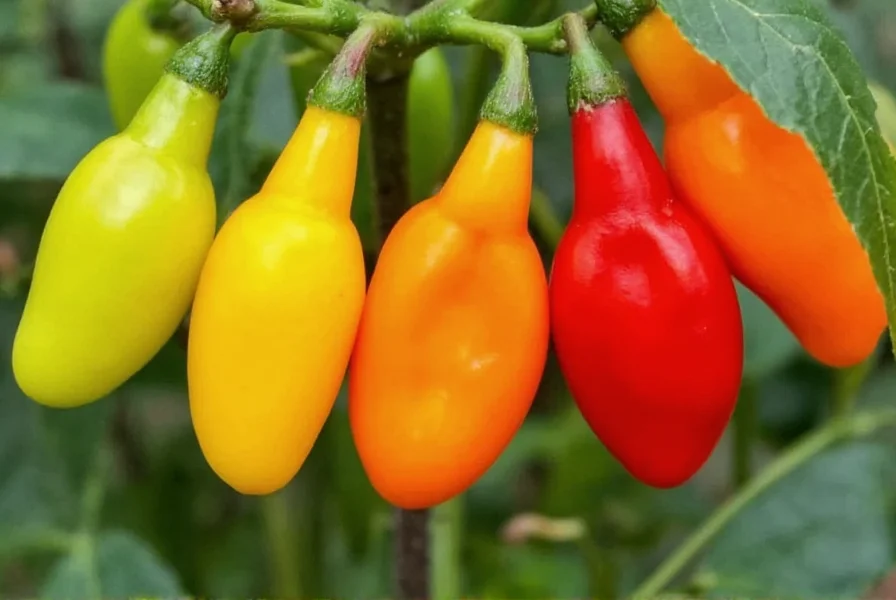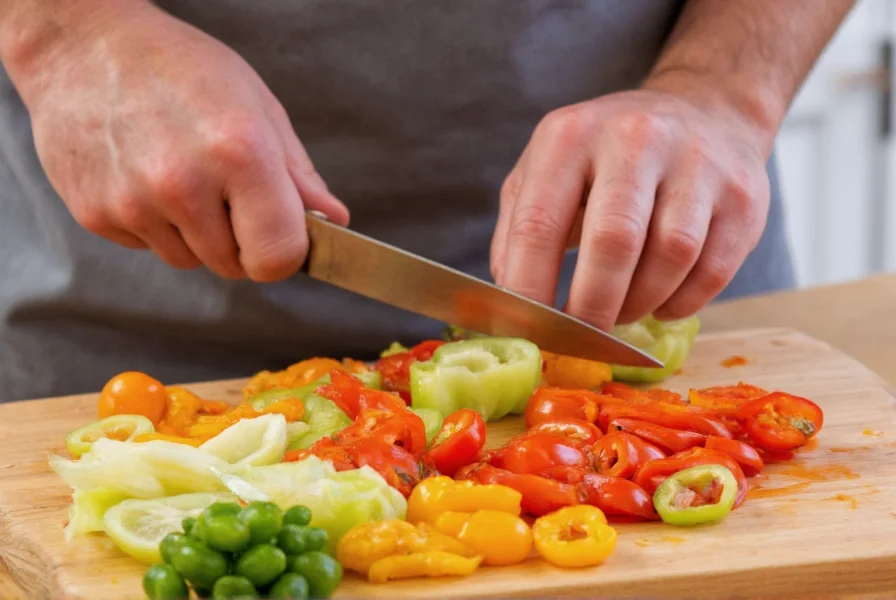The Sweety Drops pepper has gained popularity among home gardeners and culinary enthusiasts for its exceptional flavor profile and ornamental appeal. This non-spicy cultivar belongs to the Capsicum annuum species but stands apart from standard bell peppers with its distinctive physical characteristics and taste experience.
Botanical Classification and Origins
Sweety Drops (sometimes marketed as "Sweetie Drops") is a hybrid sweet pepper variety developed through selective breeding. While its exact breeding history isn't widely documented, it shares lineage with other sweet pepper varieties originating from Central and South America, where Capsicum species first evolved.
Unlike many commercial pepper varieties bred primarily for uniformity and shipping durability, Sweety Drops was developed with flavor intensity as a primary focus. The plant produces an abundance of small, elongated peppers that typically measure 2-3 inches in length with a distinctive tapered, teardrop shape that gives the variety its name.

Physical Characteristics and Ripening Process
One of the most visually striking features of Sweety Drops peppers is their dramatic color transformation as they mature:
| Stage | Color | Flavor Profile | Harvest Time (after flowering) |
|---|---|---|---|
| Immature | Yellow | Mildly sweet with vegetal notes | 50-55 days |
| Partially mature | Orange | Noticeably sweeter, fruity undertones | 60-65 days |
| Full maturity | Deep red | Maximum sweetness, complex fruity flavor | 70-75 days |
Gardeners appreciate that multiple color stages often appear simultaneously on a single plant, creating an attractive ornamental display. The thin walls of Sweety Drops peppers differentiate them from thicker-walled bell peppers, contributing to their more concentrated flavor.
Flavor Profile and Heat Level
Sweety Drops peppers register 0 Scoville Heat Units, placing them firmly in the sweet pepper category with no detectable capsaicin. What sets them apart from standard bell peppers is their significantly higher sugar content and more complex flavor profile.
When sampled side by side with traditional bell peppers, Sweety Drops offer:
- 25-30% higher sugar content
- Distinctive fruity notes reminiscent of apricot and citrus
- Less watery texture than many bell pepper varieties
- More concentrated flavor even when used in small quantities
This exceptional sweetness makes Sweety Drops particularly valuable for culinary applications where sugar content matters, such as in raw preparations, salads, and dishes where peppers aren't cooked long enough to develop sweetness through caramelization.
Growing Requirements for Home Gardeners
Sweety Drops peppers perform well in home gardens with proper care. While they share general requirements with other sweet pepper varieties, they have some specific needs to maximize yield and flavor development:
These plants typically reach 18-24 inches in height and benefit from staking as the fruit develops. One distinctive advantage for gardeners is that Sweety Drops often produces earlier than standard bell peppers, with first harvests possible approximately 50 days after transplanting.
Culinary Applications and Recipe Ideas
The intense sweetness of Sweety Drops peppers makes them exceptionally versatile in the kitchen. Unlike hot peppers that require careful handling to control heat levels, Sweety Drops can be used generously without altering a dish's fundamental flavor balance.
Professional chefs and home cooks particularly value Sweety Drops for:
- Raw applications where bell peppers often taste too mild
- Infused oils and vinegars that capture their fruity essence
- Grilling and roasting (they caramelize beautifully)
- Stuffed pepper recipes (their shape holds fillings well)
- Fresh salsas and relishes where extra sweetness enhances flavor
When substituting Sweety Drops for traditional bell peppers in recipes, consider using 25-30% less sugar in the preparation, as the peppers themselves contribute significant natural sweetness. This characteristic makes them particularly valuable for sweety drops pepper nutritional benefits in reducing added sugars in dishes while maintaining flavor complexity.
Comparison with Similar Sweet Pepper Varieties
While Sweety Drops shares characteristics with other sweet pepper varieties, several features distinguish it:
- vs Traditional Bell Peppers: Sweety Drops are smaller, thinner-walled, and significantly sweeter with more complex flavor notes. Bell peppers have a more uniform blocky shape and milder, sometimes watery flavor.
- vs Cubanelle Peppers: Cubanelles are longer and more tapered but lack the dramatic color progression and intense sweetness of Sweety Drops.
- vs Sweet Banana Peppers: Banana peppers have a similar shape but typically develop mild heat as they mature, while Sweety Drops remain completely non-spicy.
- vs Jimmy Nardello Peppers: Both have similar shapes, but Jimmy Nardellos develop mild heat (500 SHU) when fully mature, whereas Sweety Drops maintain zero heat at all stages.
For gardeners interested in growing sweety drops peppers in home garden settings, the variety offers reliable production with fewer disease issues than some heirloom sweet peppers, though it requires the same basic growing conditions as other Capsicum annuum varieties.
Nutritional Profile and Health Benefits
Sweety Drops peppers deliver impressive nutritional benefits that enhance their culinary value. Like other sweet peppers, they're rich in vitamins and antioxidants, but their higher sugar content correlates with increased concentrations of certain beneficial compounds:
- Exceptionally high vitamin C content (one medium pepper provides over 150% of daily requirement)
- Rich in vitamin A precursors (beta-carotene), especially in the orange and red stages
- Contains quercetin and other flavonoids with antioxidant properties
- Negligible calories (approximately 20 calories per medium pepper)
- Good source of dietary fiber (2g per medium pepper)
Their sweety drops pepper nutritional benefits make them particularly valuable for raw consumption, as cooking can reduce certain heat-sensitive nutrients. The vibrant color progression directly correlates with changing phytonutrient profiles, offering different health benefits at each ripening stage.
Availability and Where to Find
Sweety Drops peppers have become increasingly available in recent years, though they're still less common than standard bell peppers. You can typically find them:
- At specialty farmers' markets, particularly from late summer through fall
- In the produce section of higher-end grocery stores (Whole Foods, Wegmans, etc.)
- Through mail-order seed companies for home gardeners interested in where to buy sweety drops pepper seeds
- At u-pick farms that specialize in unique vegetable varieties
When shopping for Sweety Drops, look for firm, glossy peppers without wrinkles or soft spots. The most flavorful specimens will show some color development beyond the initial yellow stage, as sweetness increases with ripening. For those interested in sweety drops pepper plant care tips, starting from seed indoors 8-10 weeks before the last frost date typically yields the best results.

Common Questions About Sweety Drops Peppers
Are Sweety Drops peppers actually sweet with no heat?
Yes, Sweety Drops peppers consistently register 0 Scoville Heat Units, making them completely non-spicy. They're bred specifically for intense sweetness without any capsaicin, unlike some sweet pepper varieties that can develop mild heat under certain growing conditions.
How does Sweety Drops compare to bell peppers in cooking applications?
Sweety Drops offer significantly more concentrated sweetness and complex fruity flavors compared to standard bell peppers. Their thinner walls make them better suited for raw applications where bell peppers might taste too mild. In cooked dishes, Sweety Drops caramelize more readily due to higher sugar content, but they don't hold their shape as well as thicker-walled bell peppers in prolonged cooking.
Can I grow Sweety Drops peppers in containers?
Yes, Sweety Drops peppers adapt well to container growing. Use a pot that's at least 12 inches in diameter with good drainage. Container-grown plants will need more frequent watering and feeding than garden-planted specimens, but they typically produce well with proper care. The compact size of Sweety Drops plants (18-24 inches tall) makes them particularly suitable for container gardening.
Why do Sweety Drops peppers change color as they ripen?
Like all sweet peppers, Sweety Drops undergo a natural ripening process where chlorophyll breaks down and is replaced by carotenoids. The yellow-to-orange-to-red progression indicates increasing concentrations of beneficial compounds like beta-carotene and lycopene. This color change directly correlates with flavor development, as sugar content increases and complex flavor compounds develop during ripening.
Are Sweety Drops peppers genetically modified?
No, Sweety Drops peppers are conventionally bred through selective cross-pollination, not genetic modification. They're developed using traditional plant breeding techniques to enhance desirable traits like sweetness, shape, and disease resistance without introducing foreign DNA.











 浙公网安备
33010002000092号
浙公网安备
33010002000092号 浙B2-20120091-4
浙B2-20120091-4